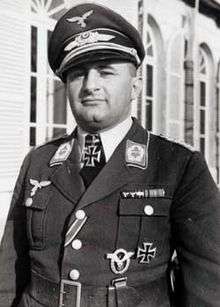Alois Lindmayr
| Alois Lindmayr | |
|---|---|
 Alois Lindmayr | |
| Born |
19 September 1901 Laibach, Austria-Hungary (now Ljubljana, Slovenia) |
| Died |
17 July 1965 (aged 63) Enns, Austria |
| Allegiance |
|
| Service/branch |
|
| Years of service | 1925–1945 |
| Commands held | 7./KG 76, I./KG 76 |
| Battles/wars | |
| Awards | Knight's Cross of the Iron Cross |
Alois Lindmayr (19 September 1901 – 17 July 1965) was a highly decorated Oberst in the Luftwaffe during World War II. He was also a recipient of the Knight's Cross of the Iron Cross. The Knight's Cross of the Iron Cross was awarded to recognise extreme battlefield bravery or successful military leadership.
After World War II Lindmayr rejoined the military service of the Austrian Armed Forces (Bundesheer) as a civil servant, holding the rank of an Amtsrat. He was unable to join the Bundesheer as an officer because he had held too high a rank (Oberst— Colonel) during the Third Reich.[1]
World War II
Lindmayr fought during the Polish Campaign and Battle of France in Kampfgeschwader 76, flying Dornier Do 17 light bombers. During the French campaign he replaced Major Ludwig Schulz as Gruppenkommandeur (Group Commander) of I Gruppe (Group) Kampfgeschwader 76 (I./KG 76) on 3 June 1940. It is unclear when he departed. It seems that he may have led the unit until 7 September 1940, or if not, later that month. He was succeeded by Hauptmann Walter Herbold.[2]

Lindmayr's most distinct action was leading two gruppen of KG 76 bombers in a raid to London on Sunday 15 September 1940 during the Battle of Britain. The day was the climax of the Battle of Britain, and became known as the Battle of Britain Day.
Lindmayr led his Dornier unit into the heart of London despite heavy attacks by RAF Fighter Command. He held his unit in formation losing eight of his 27 bombers. His experience and discipline prevented his unit suffering greater losses. In the battle, KG 76's escort, numbering some 120 Messerschmitt Bf 109s, were heavily outnumbered by RAF fighters making his leadership even more essential to the survival of his formations.[3]
Lindmayr was commander of the pilot school 123 (Flugzeugführerschule 123) in Graz-Thalerhof between February and October 1944. Not much training at this time was possible due to the fuel shortage at this stage of the war. Shortly before the end of World War II he was promoted to Oberst and made commander of the pilot school at Kaufbeuren. In this function he organized the non-hostile surrender of the city to American Forces.[4]
Awards and decorations
- Iron Cross (1939)
- Knight's Cross of the Iron Cross on 21 July 1940 as Hauptmann and Staffelkapitän of the 7./Kampfgeschwader 76[6][7]
References
Citations
- ↑ "Diplomarbeit—Der "Oberstenparagraph" im Bundesheer" (PDF). Universität Wien (in German). p. 122. Retrieved 21 February 2011.
- ↑ de Zeng 2007, p. 231.
- ↑ Price 1990, pp. 26–28.
- ↑ "Diplomarbeit—Der "Oberstenparagraph" im Bundesheer" (PDF). Universität Wien (in German). p. 123. Retrieved 21 February 2011.
- 1 2 Kaiser 2011, p. 20.
- ↑ Fellgiebel 2000, p. 293.
- ↑ Scherzer 2007, p. 508.
Bibliography
- Berger, Florian; Habisohn, Christian (2003). Ritterkreuzträger im Österreichischen Bundesheer 1955–1985 [Knight's Cross Bearers of the Austrian Armed Forces 1955–1985] (in German). Vienna, Austria: Selbstverlag Florian Berger. ISBN 978-3-9501307-2-0.
- de Zeng, Henry L., Doug G. Stankey and Eddie J. Creek. Bomber Units of the Luftwaffe 1933-1945: A Reference Source, Volume 1. Hersham, Surrey, UK: Ian Allen Publishing, 2007. ISBN 978-1-85780-279-5.
- Fellgiebel, Walther-Peer (2000) [1986]. Die Träger des Ritterkreuzes des Eisernen Kreuzes 1939–1945 — Die Inhaber der höchsten Auszeichnung des Zweiten Weltkrieges aller Wehrmachtteile [The Bearers of the Knight's Cross of the Iron Cross 1939–1945 — The Owners of the Highest Award of the Second World War of all Wehrmacht Branches] (in German). Friedberg, Germany: Podzun-Pallas. ISBN 978-3-7909-0284-6.
- Kaiser, Jochen (2011). Die Ritterkreuzträger der Kampfflieger—Band 2 (in German and English). Bad Zwischenahn, Germany: Luftfahrtverlag-Start. ISBN 978-3-941437-09-8.
- Price, Alfred. Battle of Britain Day: 15 September 1940. Greenhill books. London. 1999. ISBN 978-1-85367-375-7
- Scherzer, Veit (2007). Die Ritterkreuzträger 1939–1945 Die Inhaber des Ritterkreuzes des Eisernen Kreuzes 1939 von Heer, Luftwaffe, Kriegsmarine, Waffen-SS, Volkssturm sowie mit Deutschland verbündeter Streitkräfte nach den Unterlagen des Bundesarchives [The Knight's Cross Bearers 1939–1945 The Holders of the Knight's Cross of the Iron Cross 1939 by Army, Air Force, Navy, Waffen-SS, Volkssturm and Allied Forces with Germany According to the Documents of the Federal Archives] (in German). Jena, Germany: Scherzers Militaer-Verlag. ISBN 978-3-938845-17-2.
External links
- "Royal Air Force Historical Society Journal 29" (PDF). Royal Air Force Museum. Retrieved 20 February 2011.
- "Diplomarbeit—Der "Oberstenparagraph" im Bundesheer" (PDF). Universität Wien (in German). Retrieved 21 February 2011.